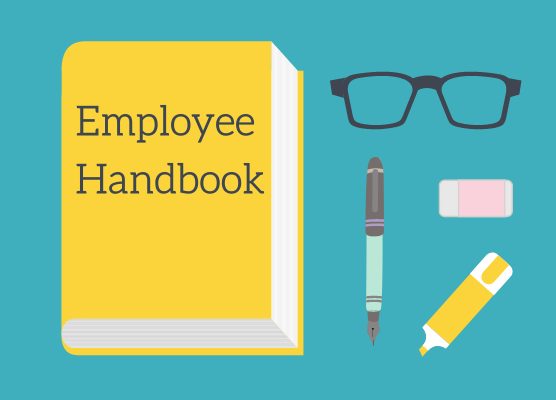Sample language for your employee handbook to keep you out of trouble
 Employee handbooks are full of often full of sample language, but is that content protecting you or leaving you at risk? Your employee handbook is a crucial management tool for sharing essential workplace rules. But getting those rules wrong can turn the tool into a weapon employment lawyers wield against your organization in court. Also, recent court decisions and the COVID-19 pandemic require employers to add new handbook provisions to fully protect themselves. Updating your handbook now is more important than ever. Here are some essential rule do’s and don’ts for handbooks.
Employee handbooks are full of often full of sample language, but is that content protecting you or leaving you at risk? Your employee handbook is a crucial management tool for sharing essential workplace rules. But getting those rules wrong can turn the tool into a weapon employment lawyers wield against your organization in court. Also, recent court decisions and the COVID-19 pandemic require employers to add new handbook provisions to fully protect themselves. Updating your handbook now is more important than ever. Here are some essential rule do’s and don’ts for handbooks.
Don’t create a contract, do specify that employment is at-will
A contract is a binding legal document. You don’t want your handbook to be considered a contract. Here’s why. You cannot change a contract without getting the other party’s consent and agreement on new language. That means that you, the employer, could not make changes without negotiating those changes with employees. Every one of those employees would have to consent. Think of it this way — your handbook would become the equivalent of a union collective bargaining agreement. Except, you would not have a union representative to negotiate with.
You can avoid creating a contract by specifically stating that the employee handbook is not a contract. You must also specify that employment is at-will. Then get employees to sign off on that statement when they receive a copy of the handbook. Do that every time you make changes to the employee handbook.
Sample language for your employee handbook
This employee handbook is not a contract. The company can change the handbook at any time, for any reason. Employment with the company is at-will. That means the company can change employment terms and terminate employment at any time, for any legal reason. No employee other than the head of the company can bind the company for anything other than at-will employment. Any employment contract must be in writing and signed by the head of the company.
If you arbitrate, create a separate arbitration agreement
Arbitration has become a popular method for employers to avoid long, drawn-out, and expensive court battles. Instead of suing, employees who have grievances against their employers must submit to arbitration. Often, employers add promises to arbitrate to employee handbooks. However, the problem with this approach is that an arbitration agreement is, in fact, a contract. By adding contract language to the handbook, you muddy the waters. A judge might later conclude that the entire handbook is a contract. Avoid this by setting out the arbitration agreement as a separate document.
Sample language for your employee handbook
The company uses arbitration as an alternative to litigation over workplace issues. You must sign a separate arbitration agreement that outlines our arbitration policy.
Include an accurate, up-to-date anti-discrimination and harassment policy
No doubt you have a general anti-discrimination policy in your handbook. But if it’s more than a year or so old, it’s probably not broad enough. Don’t simply state that you do not discriminate. Do include language consistent with the U.S. Supreme Court’s recent decisions on sexual orientation and gender identity. In those cases, the court concluded that Title VII’s sex discrimination provisions also cover sexual orientation and gender identity.
Sample language for your employee handbook
We are an equal opportunity employer. We do not discriminate on the basis of race, color, religion, sex, sexual orientation, gender identity or expression, age, disability, national origin, military service, genetic information, or any other characteristic protected by federal, state, or local laws. Neither do we tolerate discrimination or harassment based on protected characteristics from supervisors, co-workers, clients, or customers. Nor do we tolerate retaliation against employees who report violations of this policy to the human resource office. For reporting information, contact the human resource office.
Include a harassment complaint process
Your employee handbook should also include specific information about how to report discrimination, harassment, or retaliation. You may also want to include a statement encouraging or even requiring bystanders to report harassment, discrimination, and retaliation. Employers who don’t include a robust anti-harassment policy designed to prevent and stop harassment are asking for trouble. That’s because such a policy acts as a lawsuit defense if they can show the employee didn’t use the proper process. The policy must be more than a simple equal opportunity statement — it must include specific reporting steps.
Sample language for your employee handbook
We strive to create a workplace where people are treated with dignity and free from discrimination, harassment, and retaliation. We enforce these policies with education, prevention, and discipline and encourage all employees to report violations. All are covered by and are expected to comply with these policies. Managers and supervisors who allow or tolerate discrimination, harassment, or retaliation or fail to report it will be disciplined. In addition, co-workers and others not in a direct supervisory role will be disciplined for engaging in discrimination, harassment, or retaliation. Based on the seriousness of the offense, disciplinary action may include verbal or written reprimand, suspension, or termination of employment.
Reporting harassment. Employees are encouraged to report harassment promptly so that the company can take appropriate and quick action.
-
- Complaints should be submitted to the HR office as soon as possible. You may call or email the HR office, which will take the complaint. [insert appropriate contact info]
- The HR office will review the complaint, confer with the company’s legal counsel, and initiate an investigation. The investigation will determine if there was a policy violation. The investigation may include witness interviews and other relevant evidence.
- If necessary, the employee and the alleged harasser will be separated during the investigation.
- If it is determined that harassment occurred, the HR director will recommend appropriate disciplinary action. Based on the conclusion, the HR director may also recommend remedial action to address the harm done. He or she may also recommend further steps to prevent retaliation or a recurrence of harassment by this or other harassers.
 Include a dress and grooming policy that doesn’t discriminate
Include a dress and grooming policy that doesn’t discriminate
Employee handbooks almost always include dress and grooming policies that seek to create company-wide consistency. This may be a certain “look” for retail employers or a view of ‘professionalism” for banking and business settings. Almost invariably, these prescriptions for how to dress and groom run into legal trouble. The policies may discriminate based on religion, disability, race, or sex. And increasingly, state and local governments are stepping in to regulate grooming policies.
Don’t use language like this
Employees are expected to dress professionally and consistent with their position with the company. Men must be clean-shaven and have their hair no longer than the collar. Women must wear their hair in a professional style consistent with their position. No cornrows, braids, or other distracting styles allowed.
Do use language like this
All employees must dress for their position and must be clean, neat in appearance, and free of any distractions that may impair health or safety in the workplace. Employees with questions about what is acceptable may contact the HR office for guidance. Our company remains committed to supporting our employees’ religious, ethnic, cultural beliefs, and identity and will modify the dress code accordingly. Our company does not enforce the dress code in a way that reinforces stereotypes about how a particular gender should look and dress.
Include a telework policy
If we’ve learned anything from 2020, it’s that employers must be flexible and prepared for emergencies. An emergency plan that includes telework is the latest essential handbook policy. In addition, a telework policy also helps you manage reasonable accommodations for disabled workers.
Sample language for your employee handbook
We maintain a limited telework policy for those able to perform their jobs effectively from home or away from the office. A list of telework-eligible positions is available from the HR office, along with a telework agreement that outlines requirements. Telework is available in emergencies with supervisor approval and may be required for some positions. Telework is also available for those with disabilities unable to perform the essential functions of their jobs in an office environment. Contact the HR office for more information.
Include a pandemic return to work policy
It appears that the consequences of the COVID-19 pandemic will be with us for 2021. That includes planning for full or partial reopening with an eye towards preventing flare-ups. Your employee handbook needs to set standards for employee behavior. Include a pandemic return to work policy.
Sample language for your employee handbook
We are committed to preventing the spread of the COVID-19 virus in the workplace. All employees are expected to fully comply with all state, local, and federal health and safety rules. This includes social distancing and masking rules as well as symptom reporting at the beginning of each shift. We will keep you informed of the latest rules and how we will apply them.
Don’t forget to include the basics
This article covers essential do’s and don’ts that have recently changed. Your employee handbook should also cover other basics like ADA reasonable accommodations, social media policies and the FMLA and other leave policies.
Additional Resource: Consider a few other ways to modernize your employee handbook with this simple checklist.







